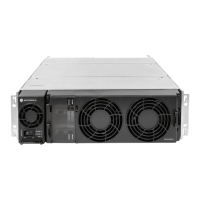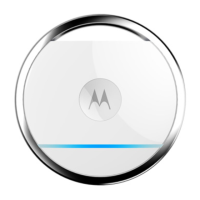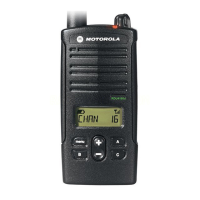Theory of Operation 4-3
• Auto refresh and self refresh modes
• Selectable output drive (DS)
• VDD/VDDQ = 1.7–1.95 V
The maximum external clock rate for the DDR is 90 MHz. Since data is transferred on both clock
edges, the effective data rate is 180 Mwords/s.
4.2.1.1.2 Flash
The SCM supports 256 MB external Tx/Rx OMAP flash memory (U1002M1 and U1600M1). The
device has the following basic characteristics:
• Four 32 KBytes Bottom Boot Sectors
• 128 KBytes main blocks (254 for 256 Mbit part, 514 for 512 MBit part)
• 1.8V VCC and VCCO
4.2.2 Serial Peripheral Interface (SPI)
The station local and Intermodule SPI Bus is controlled by both Tx and Rx OMAP1710 processors,
which has an on-chip SPIF (fast SPI) interface. The OMAP1710 SPIF supports master and slave
modes, programmable clock rate, phase, polarity, programmable word size, programmable bit
ordering, and loopback.
Before an SPI data transfer can take place, the SPI master (initiator) must assert the select line of
the slave (target) device. The OMAP1710 is always the SPI master for MTR3000 base station/
repeater. To simplify overall SPI architecture for MTR3000 base station/repeater, address decoding
is used instead of individual device chip signals. This approach not only minimizes the number of
GPIOs needed for device chip select, it also provides flexibility for future expansion. This device
address decoding is handled by an Field Programmable Gate Array (FPGA) on the SCM and a
Customer Programmable Logic Device (CPLD) on each FRU’s, except the power supply.
The FPGA SPI module performs address and chip select decoding, level shifting, and signal mixing
for both the Tx OMAP SPI bus and the Rx OMAP SPI bus. Simultaneous Rx and Tx SPI accesses
are allowed. The Tx and Rx SPI are 100% independent.
Table 4-1 SPI decoding truth table
Signal Name Section
Device CS
(DCS4:DCS1)
SPI Address
(A2:A0)
OMAP
GPIO16
OMAP
SPI_NCS3x
Enable Enable
Default No device selected 1111 111 x 1
OP1_CS1x BP 0000 111 x 0
OP1_CS2x BP 0001 111 x 0
OP1_CS3x BP 0010 111 x 0
OP2_CS1x BP 0011 111 x 0
OP2_CS2x BP 0100 111 x 0
OP2_CS3x BP 0101 111 x 0

